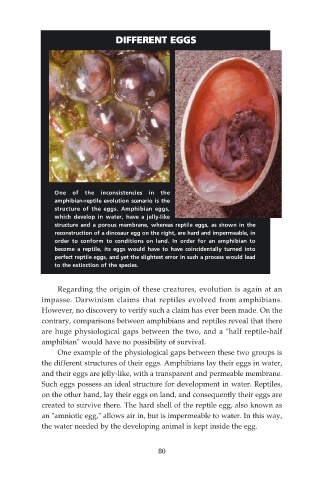Page 82 - Darwinism Refuted
P. 82
D DIFFERENT EGGS
One of the inconsistencies in the
amphibian-reptile evolution scenario is the
structure of the eggs. Amphibian eggs,
which develop in water, have a jelly-like
structure and a porous membrane, whereas reptile eggs, as shown in the
reconstruction of a dinosaur egg on the right, are hard and impermeable, in
order to conform to conditions on land. In order for an amphibian to
become a reptile, its eggs would have to have coincidentally turned into
perfect reptile eggs, and yet the slightest error in such a process would lead
to the extinction of the species.
Regarding the origin of these creatures, evolution is again at an
impasse. Darwinism claims that reptiles evolved from amphibians.
However, no discovery to verify such a claim has ever been made. On the
contrary, comparisons between amphibians and reptiles reveal that there
are huge physiological gaps between the two, and a "half reptile-half
amphibian" would have no possibility of survival.
One example of the physiological gaps between these two groups is
the different structures of their eggs. Amphibians lay their eggs in water,
and their eggs are jelly-like, with a transparent and permeable membrane.
Such eggs possess an ideal structure for development in water. Reptiles,
on the other hand, lay their eggs on land, and consequently their eggs are
created to survive there. The hard shell of the reptile egg, also known as
an "amniotic egg," allows air in, but is impermeable to water. In this way,
the water needed by the developing animal is kept inside the egg.
80

